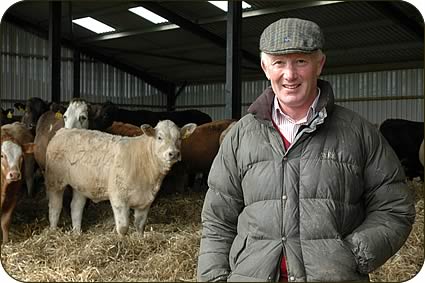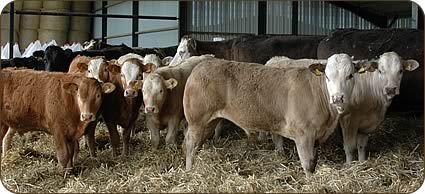Jennifer MacKenzie is an agricultural photo journalist with almost 30 year's experience. Operating from her base in Cumbria, Jennifer undertakes mainly industry-related freelance writing and photography.
Blonde bulls tried and tested
Blonde d’Aquitaine bulls are the tried and tested sire for Roland Telford on his herd of more than 400 suckler cows run in the foothills of the Cheviot hills in Northumberland.
The herd at Branton East Side, Powburn, near Alnwick, has expanded to 420 cows in recent years – and now all nine stock bulls are pedigree Blondes which Mr Telford finds produce easily calved and easily managed progeny that still provide a return comparable with other continental crosses when sold as suckled calves.
 |
Mr Telford and his wife Kathleen farm 3,000 acres, 860 of which are family owner-occupied, on the edge of the Cheviot hills. The farm employs three shepherds and three general workers, with no contractors employed.
The farm is a mix of lowland and LFA with the suckler herd grazing the higher ground during the summer and the Blonde crosses have proved to be the ideal calf.
“We have found by using the Blonde bull that the cows are easier calving and as a result the cows live longer. The growth rates of the calves are very good and they have the potential to put on good flesh and weight with the killing out percentage of the cattle a good selling point,” said Mr Telford.
“With the Single Farm Payment and the second beef premium no longer being an issue, producers will be pushing their cattle on to finish quicker on reasonably intensive systems - which should come out in favour of the Blonde breed with its fast finishing qualities at good weights and good killing out percentages,” he added.
The suckler herd was originally made up of Irish cross cows, however to help minimise disease risks, home-bred heifers mainly Limousin cross out of Friesian and Holstein cows are now sourced mainly from breeders through Carlisle market and privately in the north.
A herd of 90 cows, mainly Simmental crosses, was taken on in 2002 with an extra 600 acres of land.
“We fell into the Blondes almost by accident more than 20 years ago. We had been using predominantly Charolais bulls on our cows and the Hereford on the heifers. We bought a Limousin and a Blonde bull at the same time but we found that the Blondes grew faster.
“At the time I farmed with my father and brother and we had a lot of hill land some of which I continued to farm when we split the partnership when my father retired in the mid 1980s. The majority of my suckler herd was on quite high ground and I felt that the cows were not able to do so well when suckling the larger-boned Charolais calves as with Blonde calves.
“I was also finishing cattle on low-lying land near the coast at Beadnell and I thought the Blonde crosses were doing the best and we were getting more per kg. As a result, every time I needed to replace a bull I bought the best Blonde I could get,” said Mr Telford.
“I look for bulls with a good top which are not too narrow while length and lack of belly are a natural breed trait.”
Current stock bulls are by Ballygowan Noble, Whistley Dollar, Druk Lance and the French bred bull Everest – Mr Telford is prepared to pay a good price for a top Blonde bull but he believes he would have to pay nearly twice that for the length and quality from another continental breed.
The most recent two stock bulls were bought from George Hamilton, of Ramrigg. They were the herd’s three and an half year old stock bull as well as a bull bred by Mr Hamilton from an in-calf heifer – both were from the County Durham based Hallfield herd of James Weightman.
By the mid 1990s, the suckler herd had expanded to 300 cows following the purchase of more land at Branton and while some heifers were still finished on the farm, suckled calves were also sold through Wooler Mart’s autumn and spring sales.
Currently, all the progeny are sold as suckled calves, either through Wooler or privately.
Of the herd, 220 calve in the spring from mid March to mid June, with the remainder calving from the end of August through September and October. The aim is for a nine to 12 week calving period. Assisted calvings count for as little as 10 per cent of the herd.
 |
| Crossbred Blonde calves |
Spring-born calves are sold the following February and March at 10 to 12 months old after weaning in January – leaving the calves on their mothers after housing has been found to reduce pneumonia.
The autumn-born calves are weaned in mid August and are sold in October. All cows are winter housed and the spring calvers are inoculated with Rotavec against scour.
Only the autumn-born calves are creep fed receiving less than a kg a day of a home-grown barley mix with the spring calves going out to graze the hill with their mothers.
Calves are weighed when handled on a tray in a race and generally average a liveweight gain of 1kg-plus a day from birth to sale for steers and approaching 1kg a day for heifers and their sale weights are equivalent to other larger continental beef breeds, says Mr Telford
The 180 calves sold in October 2004 averaged £510 for steers and £430 for heifers.
With 400 acres of cereals grown at Branton East Side, Mr Telford can also keep his options open under the new Single Farm Payment regime and cut cow numbers and finish his cattle.
“I would stick with the Blonde because I know how well they finish but at the moment if I can sell a store calf at 10 to 14 months old at about £500 for a steer and £400 for a heifer then I will continue to sell the calves.
“It also depends on what it costs you to winter a cow and we have got land which suits suckler cows.”
Another incentive to maintain suckler herd numbers will be the lifting of the Over Thirty Months Scheme. An extra £200 per cow could go further towards herd replacement costs.
The suckler herd also improves the grazing for the farm’s 2,200 ewes and 600 ewe hoggs, 850 of which are North Country Cheviots, a further 850 Blackface plus 500 Mule and crossbred ewes, with 300ewe lambs and 300 gimmers sold annually along with up to 2,500 finished lambs.

